Worst-Case Energy Efficiency Maximization in a 5G Massive MIMO-NOMA System
Abstract
:1. Introduction
1.1. Summary of Contribution
- In this paper, we investigate the EE maximization problem in a multicell massive MIMO-NOMA downlink system. The EE maximization problem is formulated under the constraints of transmission power and the minimum signal-to-interference-plus-noise-power-ratio (SINR) requirement for the CE users. The considered problem has non-convex fractional objective function, which is intractable and difficult to solve.
- We first turn the fractional objective function into an equivalent parametric one by introducing a non-negative parameter. Successive convex approximation (SCA) method is further employed to solve the dual problem for minimizing the transmission power at the BS and also to find the upper bound values for the original convex optimization problem.
- We propose a joint robust beamforming and EE maximization (JRBEE) algorithm established on the constrained concave–convex procedure (CCCP) and the Dinkelbach method that solve and achieve the convergence to a stationary point of the above problem. The JRBEE algorithm determines the optimal beamforming vector, which helps to maximize the worst-case EE.
- Moreover, we also propose a novel JUPDPA algorithm based on the median and the Euclidean norm of the channel vectors. The JUPDPA algorithm helps to minimize the inter-user interference and also enhance the fairness between the users by dynamically allocating the transmission power to the paired users.
- Simulation results guarantee the convergence property of our proposed EE maximization algorithm and showed that the proposed scheme can significantly improve the worst-case energy efficiency compared to the existing NOMA schemes and the conventional OMA scheme.
1.2. Organization
2. System Model and Problem Formulation
2.1. Transmitter
2.2. Channel Model
2.3. Receiver
2.3.1. Cell Center User
2.3.2. Cell Edge User
2.3.3. Energy Efficiency
2.4. Problem Formulation
3. A Novel Joint User Pairing and Dynamic Power Allocation Algorithm
3.1. User Pairing Scheme
3.2. Dynamic Power Allocation Scheme
| Algorithm 1 Proposed JUPDPA Algorithm. |
. : Initialize , , , and .
. : Select a user from CC group and calculate the difference in the Euclidean norm between that user and all the available users from the CE group, which are ordered in descending order. The proposed user pairing scheme is given in the below figure.
 If the selected user from the CC group is odd numbered, then choose the least difference Euclidean norm user from the CE group for pairing. However, for the even numbered CC user, choose the user from the CE group that has the largest difference in the Euclidean norm of the channel vectors.
If the selected user from the CC group is odd numbered, then choose the least difference Euclidean norm user from the CE group for pairing. However, for the even numbered CC user, choose the user from the CE group that has the largest difference in the Euclidean norm of the channel vectors.. : Remove the selected users from (20) and (21). Save them in , where m represents the user pair index: . : Paired users will be allocated transmission power based on the dynamic power allocation scheme as given in Table 1. . : Remaining unpaired users will be serviced based on the OMA scheme. . : Halt the Algorithm. |
4. Proposed Joint Robust Beamforming and Energy Efficiency Maximization Algorithm
| Algorithm 2 Proposed JRBEE maximization Algorithm. |
. : Input: and let . Output: and . : 2.1 Initialize the variable , to a arbitrary positive semidefinite matrix (feasible) Repeat
2.2 Calculate the linear beamformer for m pairs and SINR for all users. 2.3 Initialize with the help of obtained by solving (45) and set . Repeat
2.4 Determine the optimal beamformer that achieves minimum transmission power. . Obtain the EE by substituting into the (26) and find the value of . . Update in step 1 and repeat the procedure until the convergence criteria is satisfied to find . |
Complexity Analysis for the Proposed Algorithms
5. Numerical Results and Discussion
6. Conclusions
Acknowledgments
Author Contributions
Conflicts of Interest
Abbreviations
| JUPDPA | joint user pairing and dynamic power allocation |
| JRBEE | joint robust beamforming and energy efficiency maximization |
| EUM | ellipsoidal uncertainty model |
| EE | energy efficiency |
| SDR | semi definite relaxation |
| SCA | successive convex approximation |
| SINR | signal-to-interference-plus-noise-power-ratio |
| EEmax | energy efficiency maximization |
| CCCP | constrained concave-convex procedure |
| ZFBF | zero forcing beamforming |
| FPA | fixed power allocation |
| Ratemax | achievable rate maximization |
| NOMA | non-orthogonal multiple access |
| OMA | orthogonal multiple access |
| MIMO | multiple-input-multiple-output |
| CSIT | channel state information at the transmitter |
| CSI | channel state information |
| BS | base station |
| i.i.d | independent and identically distributed |
| MMSE | minimum mean square error |
| RUPFPA | random user pairing and fixed power allocation |
| PFUPPA | proportional fairness based user pairing and power allocation |
| DPA | dynamic power allocation |
References
- Andrews, J.G.; Buzzi, S.; Choi, W. What Will 5G Be? IEEE J. Sel. Areas Commun. 2014, 32, 1065–1082. [Google Scholar] [CrossRef]
- I, C.-L.; Rowell, C.; Han, S.; Xu, Z.; Li, G.; Pan, Z. Toward green and soft: A 5G perspective. IEEE Commun. Mag. 2014, 13, 66–73. [Google Scholar] [CrossRef]
- Bjornson, E.; Sanguinetti, L.; Hoydis, J.; Debbah, M. Optimal Design of Energy-Efficient Multi-User MIMO Systems: Is Massive MIMO the Answer? IEEE Trans. Wirel. Commun. 2015, 14, 3059–3075. [Google Scholar] [CrossRef]
- Li, J.; Wen, M.; Cheng, X.; Yan, Y.; Song, S.; Lee, M.H. Generalized Precoding-Aided Quadrature Spatial Modulation. IEEE Trans. Veh. Technol. 2017, 66, 1881–1886. [Google Scholar] [CrossRef]
- Wen, M.; Basar, E.; Li, Q.; Zheng, B.; Zhang, M. Multiple-Mode Orthogonal Frequency Division Multiplexing With Index Modulation. IEEE Trans. Commun. 2017, 65, 3892–3906. [Google Scholar] [CrossRef]
- Wen, M.; Cheng, X.; Ma, M.; Jiao, B.; Poor, H.V. On the Achievable Rate of OFDM with Index Modulation. IEEE Trans. Signal Process. 2016, 64, 1919–1932. [Google Scholar] [CrossRef]
- Khan, M.S.; Maeng, S.J.; Cho, Y.S. Cell Selection Technique for Millimeter-Wave Cellular Systems with Hybrid Beamforming. Sensors 2017, 17, 1461. [Google Scholar] [CrossRef] [PubMed]
- Liu, X.; Xiao, Z.; Bai, L.; Choi, J.; Xia, P.; Xia, X.G. Beamforming Based Full-Duplex for Millimeter-Wave Communication. Sensors 2016, 16, 1130. [Google Scholar] [CrossRef] [PubMed]
- Ding, Z.; Lei, X.; Karagiannidis, G.K.; Schober, R.; Yuan, J.; Bhargava, V. A survey on non-orthogonal multiple access for 5G networks: Research challenges and future trends. IEEE J. Sel. Areas Commun. 2017, 35. [Google Scholar] [CrossRef]
- Islam, S.M.R.; Avazov, N.; Dobre, O.A.; Kwak, K.S. Power-domain non-orthogonal multiple access (NOMA) in 5G systems: Potentials and challenges. IEEE Commun. Surv. Tutor. 2017, 19, 721–742. [Google Scholar] [CrossRef]
- Benjebbour, A.; Saito, K.; Li, A.; Kishiyama, Y.; Nakamura, T. Nonorthogonal multiple access (NOMA): Concept, performance evaluation and experimental trials. In Proceedings of the 2015 International Conference on Wireless Networks and Mobile Communications (WINCOM), Marrakech, Morocco, 20–23 October 2015. [Google Scholar]
- Choi, J. Minimum power multicast beamforming with superposition coding for multiresolution broadcast and application to NOMA systems. IEEE Trans. Commun. 2015, 63, 791–800. [Google Scholar] [CrossRef]
- Xiao, Z.; Liu, H.; Havyarimana, V.; Li, T.; Wang, D. Analytical study on multi-tier 5G heterogeneous small cell networks: Coverage performance and energy efficiency. Sensors 2016, 16, 1854. [Google Scholar] [CrossRef] [PubMed]
- Porcel-Rodriguez, F.; Valenzuela-Valdes, J.; Padilla, P.; Luna-Valero, F.; Luque-Baena, R.; Lopez-Gordo, M.A. Clustering and beamforming for efficient communication in wireless sensor networks. Sensors 2016, 16, 1334. [Google Scholar] [CrossRef] [PubMed]
- Buzzi, S.; I, C.-L.; Klein, T.E.; Poor, H.V.; Yang, C.; Zappone, A. A survey of energy-efficient techniques for 5G networks and challenges ahead. IEEE J. Sel. Areas Commun. 2016, 34, 697–709. [Google Scholar] [CrossRef]
- Ding, Z.; Liu, Y.; Choi, J.; Sun, Q.; Elkashlan, M.; I, C.-L.; Poor, H.V. Application of non-orthogonal multiple access in LTE and 5G networks. IEEE Commun. Mag. 2017, 55, 185–191. [Google Scholar] [CrossRef]
- Xin, Y.; Wang, D.; Li, J.; Zhu, H.; Wang, J.; You, X. Area spectral efficiency and area energy efficiency of massive MIMO cellular systems. IEEE Trans. Veh. Technol. 2016, 65, 3243–3254. [Google Scholar] [CrossRef]
- Ding, Z.; Adachi, F.; Poor, H.V. The application of MIMO to non-orthogonal multiple access. IEEE Trans. Wirel. Commun. 2016, 15, 537–552. [Google Scholar] [CrossRef]
- Ngo, H.Q.; Larsson, E.G.; Marzetta, T.L. Energy and spectral efficiency of very large multiuser MIMO systems. IEEE Trans. Commun. 2013, 61, 1436–1449. [Google Scholar] [CrossRef]
- Sun, X.; Duran-Herrmann, D.; Zhong, Z.; Yang, Y. Non-orthogonal multiple access with weighted sum-rate optimization for downlink broadcast channel. IEEE MILCOM 2015, 15, 1176–1181. [Google Scholar] [CrossRef]
- Kim, B.; Lim, S.; Kim, H. Non-orthogonal Multiple Access in a Downlink Multiuser Beamforming System. In Proceedings of the 2013 IEEE Military Communications Conference (MILCOM), San Diego, CA, USA, 18–20 November 2013. [Google Scholar]
- Ding, Z.; Fan, P.; Poor, H.V. Impact of user pairing on 5G nonorthogonal multiple access. IEEE Trans. Veh. Technol. 2016, 65, 6010–6023. [Google Scholar] [CrossRef]
- Liu, F.; Mahonen, P.; Petrova, M. Proportional fairness-based power allocation and user set selection for downlink NOMA systems. In Proceedings of the 2016 IEEE International Conference on Communications (ICC), Kuala Lumpur, Malaysia, 22–27 May 2016. [Google Scholar]
- Seyama, T.; Dateki, T.; Seki, H. Efficient selection of user sets for downlink non-orthogonal multiple access. In Proceedings of the 2015 IEEE 26th Annual International Symposium on Personal, Indoor, and Mobile Radio Communications (PIMRC), Hong Kong, China, 30 August–2 September 2015. [Google Scholar]
- Parida, P.; Das, S. Power allocation in OFDM based NOMA systems: A DC programming approach. In Proceedings of the 2014 Globecom Workshops (GC Wkshps), Austin, TX, USA, 8–12 December 2014. [Google Scholar]
- Al-Abbasi, Z.Q.; So, D.K. User-pairing based non-orthogonal multiple access (NOMA) system. In Proceedings of the 2016 IEEE 83rd Vehicular Technology Conference (VTC Spring), Nanjing, China, 15–18 May 2016. [Google Scholar]
- Pascual-Iserte, A.; Palomar, D.P.; Perez-Neira, A.I.; Lagunas, M.A. A robust maximin approach for MIMO communications with imperfect channel state information based on convex optimization. IEEE Trans. Signal Process. Soc. 2006, 54, 346–360. [Google Scholar] [CrossRef] [Green Version]
- Liang, W.; Ding, Z.; Li, Y.; Song, L. User Pairing for Downlink Non-Orthogonal Multiple Access Networks using Matching Algorithm. IEEE Trans. Commun. 2017, 32, 1065–1082. [Google Scholar] [CrossRef]
- He, J.; Tang, Z. Low-complexity user pairing and power allocation algorithm for 5G cellular network non-orthogonal multiple access. Electron. Lett. 2017, 53, 626–627. [Google Scholar] [CrossRef]
- Zhang, Y.; Wang, H.M.; Ng, D.W.K.; Lee, M.H. NOMA in Downlink SDMA with Limited Feedback: Performance Analysis and Optimization. IEEE J. Sel. Areas Commun. 2017, 20. [Google Scholar] [CrossRef]
- Zhang, Y.; Wang, H.M.; Yang, Q.; Ding, Z. Secrecy sum rate maximization in non-orthogonal multiple access. IEEE Commun. Lett. 2016, 20, 930–933. [Google Scholar] [CrossRef]
- Shi, L.; Li, B.; Chen, H. Pairing and Power Allocation for Downlink Non-Orthogonal Multiple Access Systems. IEEE Trans. Veh. Technol. 2017, 99, 1. [Google Scholar] [CrossRef]
- Shahab, M.B.; Kader, M.F.; Shin, S.Y. A Virtual User Pairing Scheme to Optimally Utilize the Spectrum of Unpaired Users in Nonorthogonal Multiple Access. IEEE Signal Process. Lett. 2016, 23, 1766–1770. [Google Scholar] [CrossRef]
- Zhang, Y.; Wang, H.M.; Zheng, T.X.; Yang, Q. Energy-efficient transmission design in non-orthogonal multiple access. IEEE Trans. Veh. Technol. 2016, 66, 2852–2857. [Google Scholar] [CrossRef]
- Fang, F.; Zhang, H.; Cheng, J.; Leung, V.C.M. Energy-efficient resource allocation for downlink non-orthogonal multiple access network. IEEE Trans. Commun. 2016, 64, 3722–3732. [Google Scholar] [CrossRef]
- Han, S.; I, C.-L.; Xu, Z. Energy Efficiency and Spectrum Efficiency Co-Design: From NOMA to Network NOMA. MMTC E-Lett. 2014, 9, 21–24. [Google Scholar]
- Zhang, Y.; Yang, Q.; Zheng, T.X.; Wang, H.M.; Meng, Y. Energy efficiency optimization in cognitive radio inspired non-orthogonal multiple access. In Proceedings of the 2016 IEEE 27th Annual International Symposium on Personal, Indoor, and Mobile Radio Communications (PIMRC), Valencia, Spain, 4–8 September 2016. [Google Scholar]
- Sun, Q.; Han, S.; Chin-Lin, I.; Pan, Z. Energy efficiency optimization for fading MIMO non-orthogonal multiple access systems. In Proceedings of the 2015 IEEE International Conference on Communications (ICC), London, UK, 8–12 June 2015. [Google Scholar]
- Zappone, A.; Lin, P.; Jorswieck, E.A. Energy efficiency in secure multi-antenna systems. arXiv, 2016; arXiv:1505.02385. [Google Scholar]
- Kay, S.M. Fundamentals of Statistical Signal Processing: Estimation Theory; Prentice Hall PTR: Upper Saddle River, NJ, USA, 1993; ISBN 9780133457117. [Google Scholar]
- Yuille, A.L.; Rangarajan, A. The Concave-convex Procedure. Neural Comput. 2003, 15, 915–936. [Google Scholar] [CrossRef] [PubMed]
- Lipp, T.; Boyd, S. Variations and extension of the convex-concave procedure. Optim. Eng. 2016, 17, 263–287. [Google Scholar] [CrossRef]
- Dinkelbach, W. On nonlinear fractional programming. Manag. Sci. 1967, 7, 492–498. [Google Scholar] [CrossRef]
- Zappone, A.; Jorswieck, E. Energy efficiency in wireless networks via fractional programming theory. Found. Trends Commun. Inf. Theor. 2015, 11, 185–396. [Google Scholar] [CrossRef]
- Luo, Z.Q.; Ma, W.K.; So, A.M.; Ye, Y.; Zhang, S. Semidefinite relaxation of quadratic optimization problems. IEEE Signal Process. Mag. 2010, 27, 20–34. [Google Scholar] [CrossRef]
- Boyd, S.; Vandenberghe, L. Convex Optimization; Cambridge University Press: Cambridge, UK, 2004; ISBN 0521833787. [Google Scholar]
- Hong, M.; Li, Q.; Liu, Y.F. Decomposition by successive convex approximation: A unifying approach for linear transceiver design in heterogeneous networks. IEEE Trans. Wirel. Commun. 2016, 15, 1377–1392. [Google Scholar] [CrossRef]
- Nesterov, Y.; Nemirovsky, A. Interior Point Polynomial Algorithms in Convex Programming. SIAM 1994. [Google Scholar] [CrossRef]
- Tse, D.; Viswanath, P. Fundamentals of Wireless Communication; Cambridge University Press: New York, NY, USA, 2005; ISBN 0-5218-4527-0. [Google Scholar]
- Jain, R.K.; Chiu, D.M.W.; Hawe, W.R. A Quantitative Measure of Fairness and Discrimination for Resource Allocation and Shared Computer System; Technical Report DEC-TR-301; Digital Equipment Corporation: Hudson, MA, USA, 1984; Available online: https://arxiv.org/abs/cs/9809099v1 (accessed on 15 August 2017).
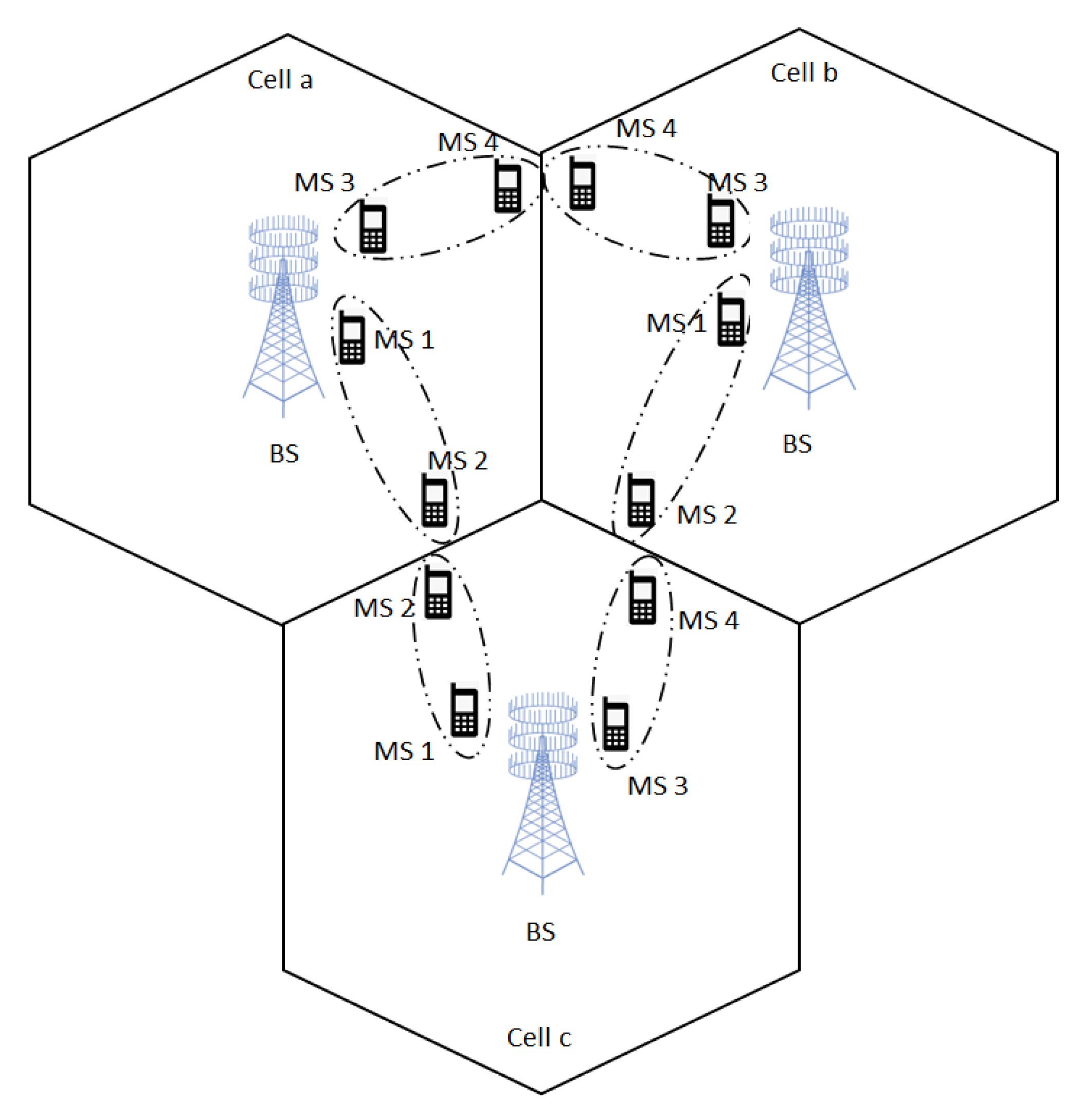
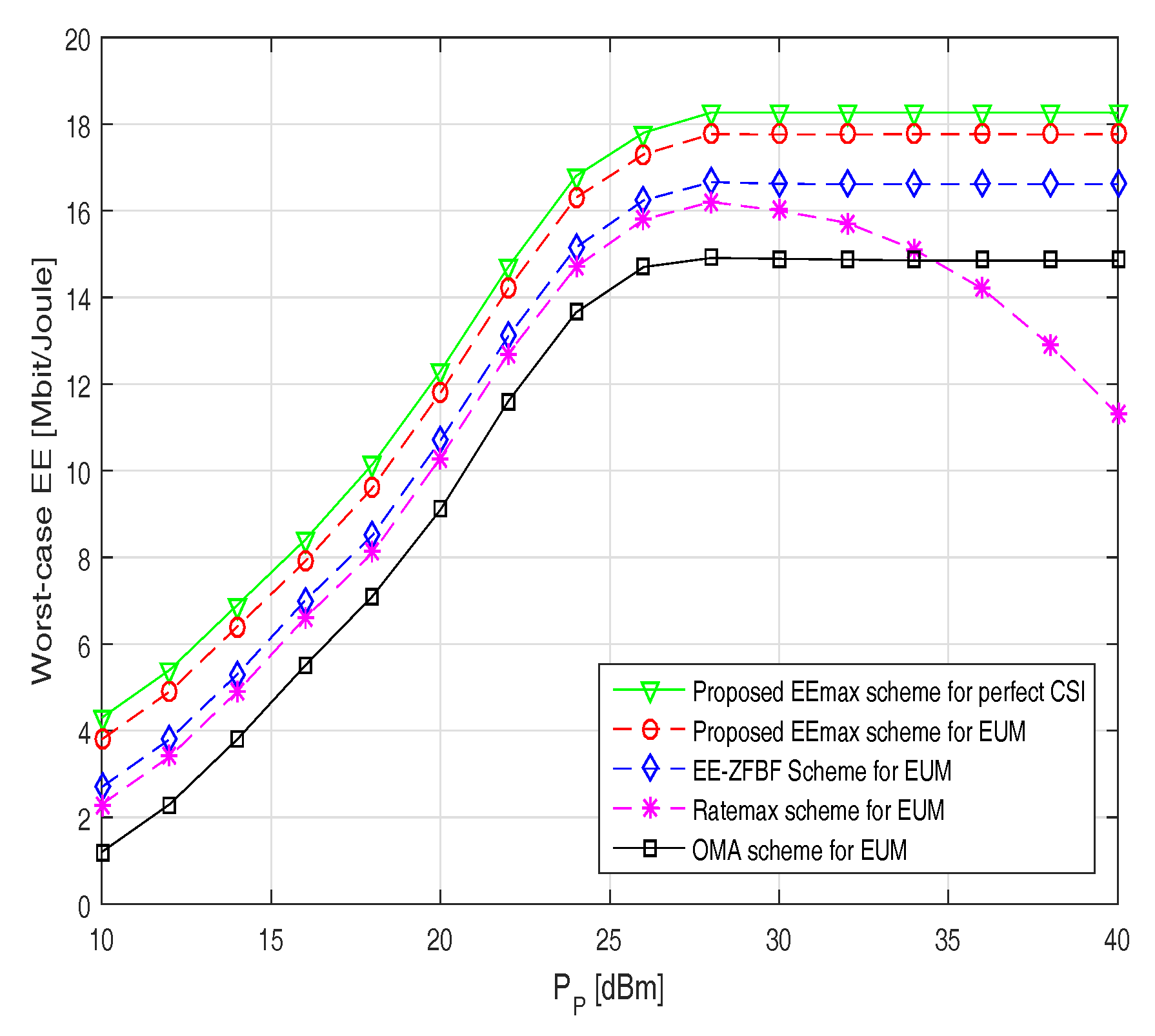
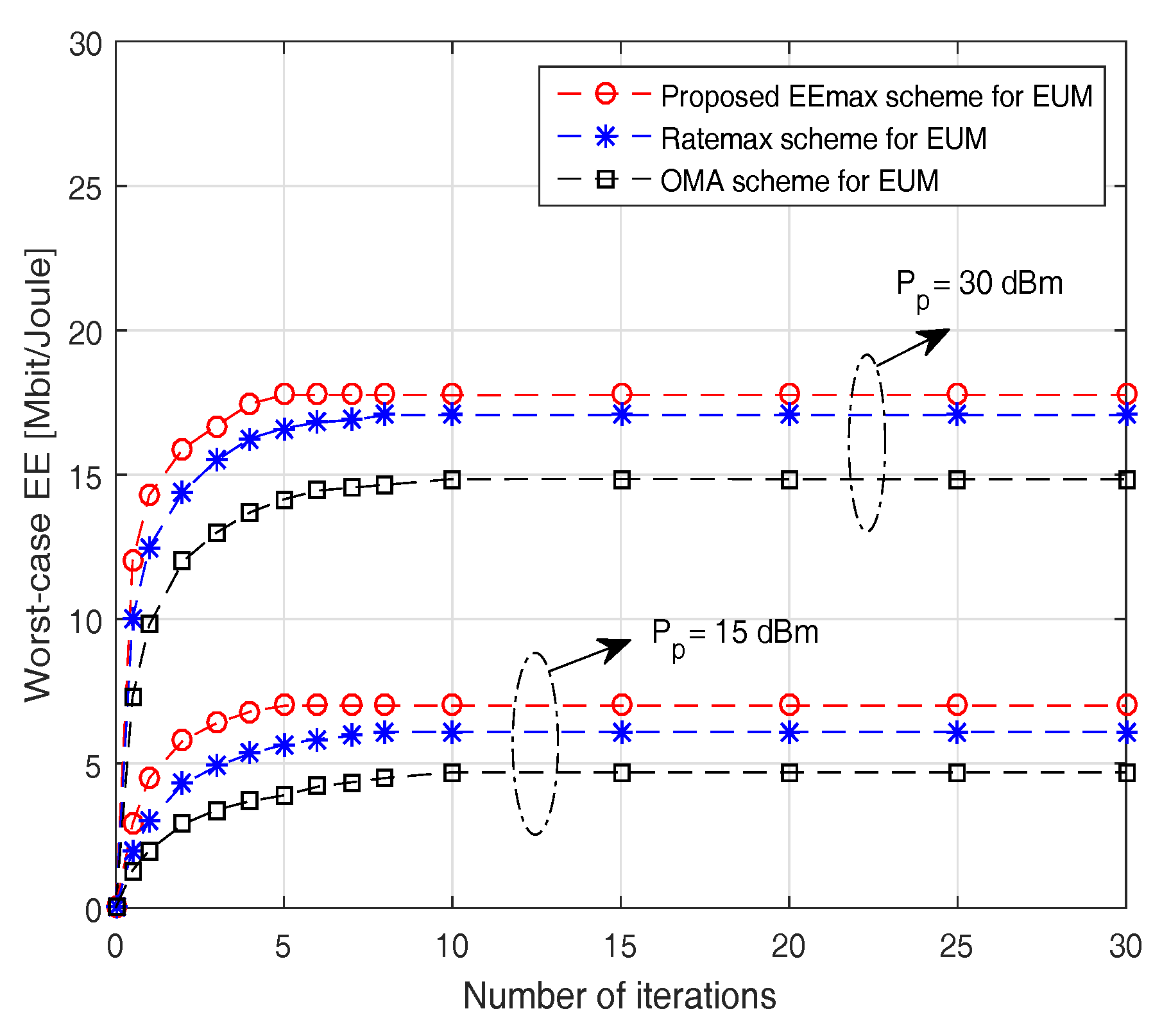
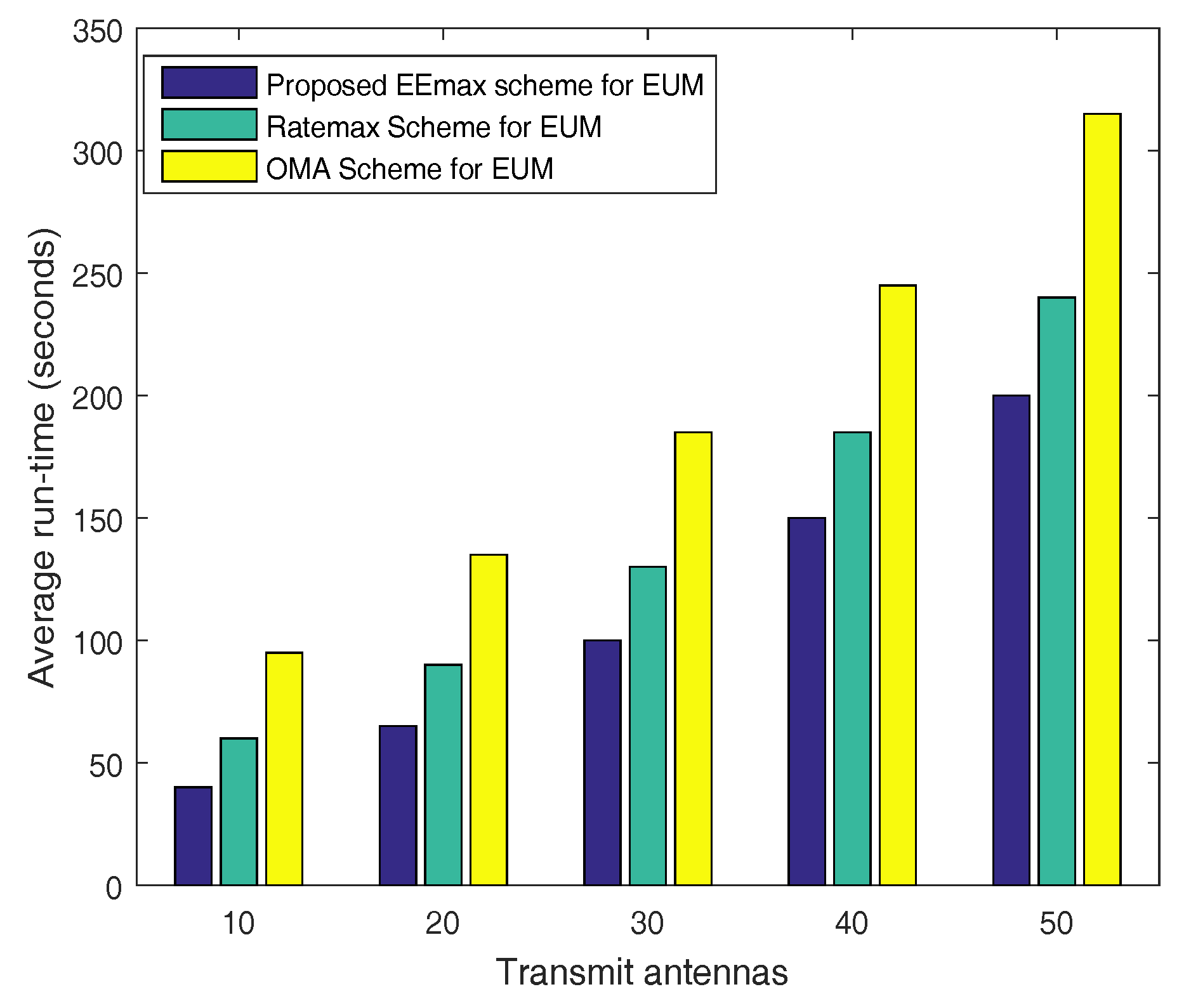
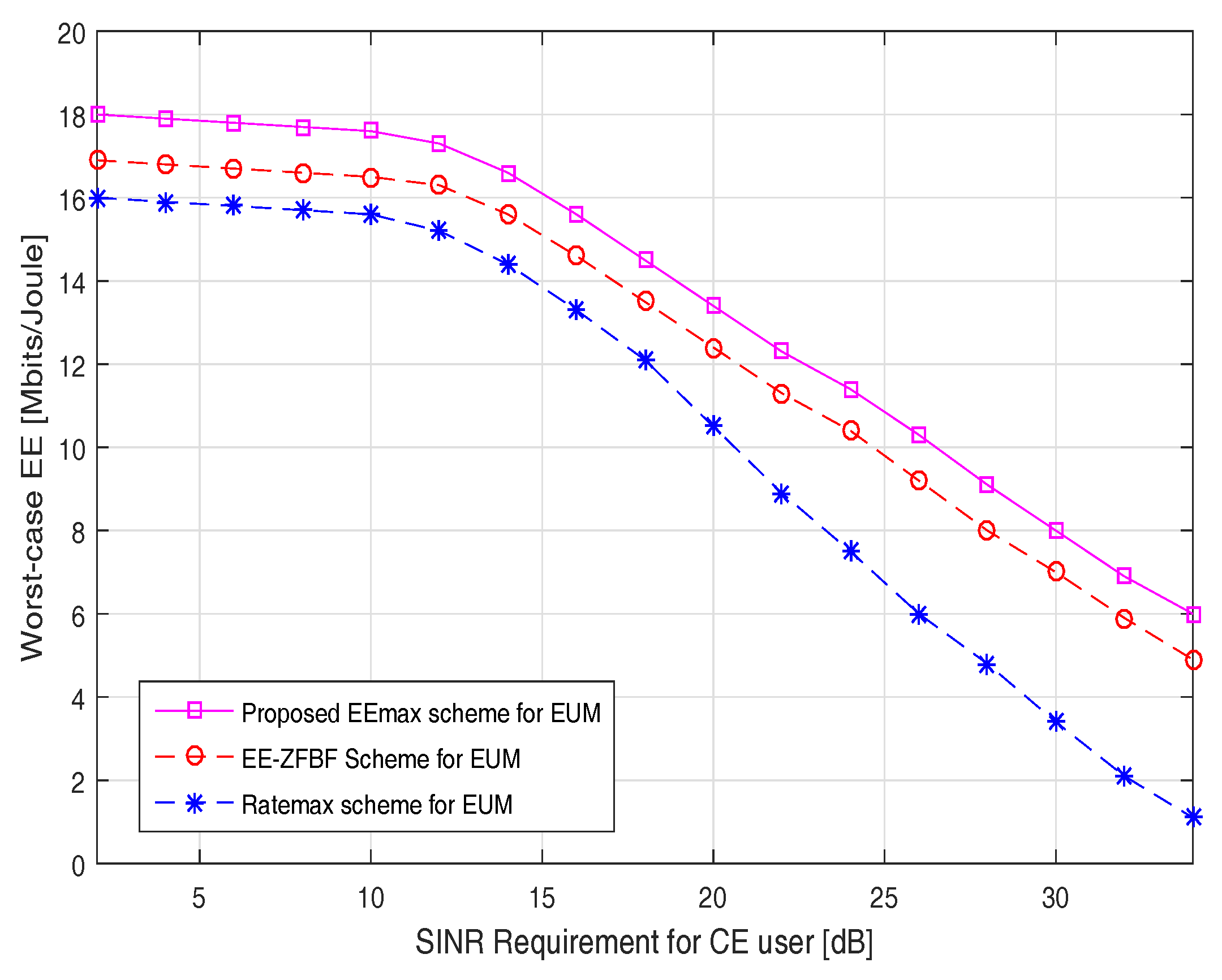
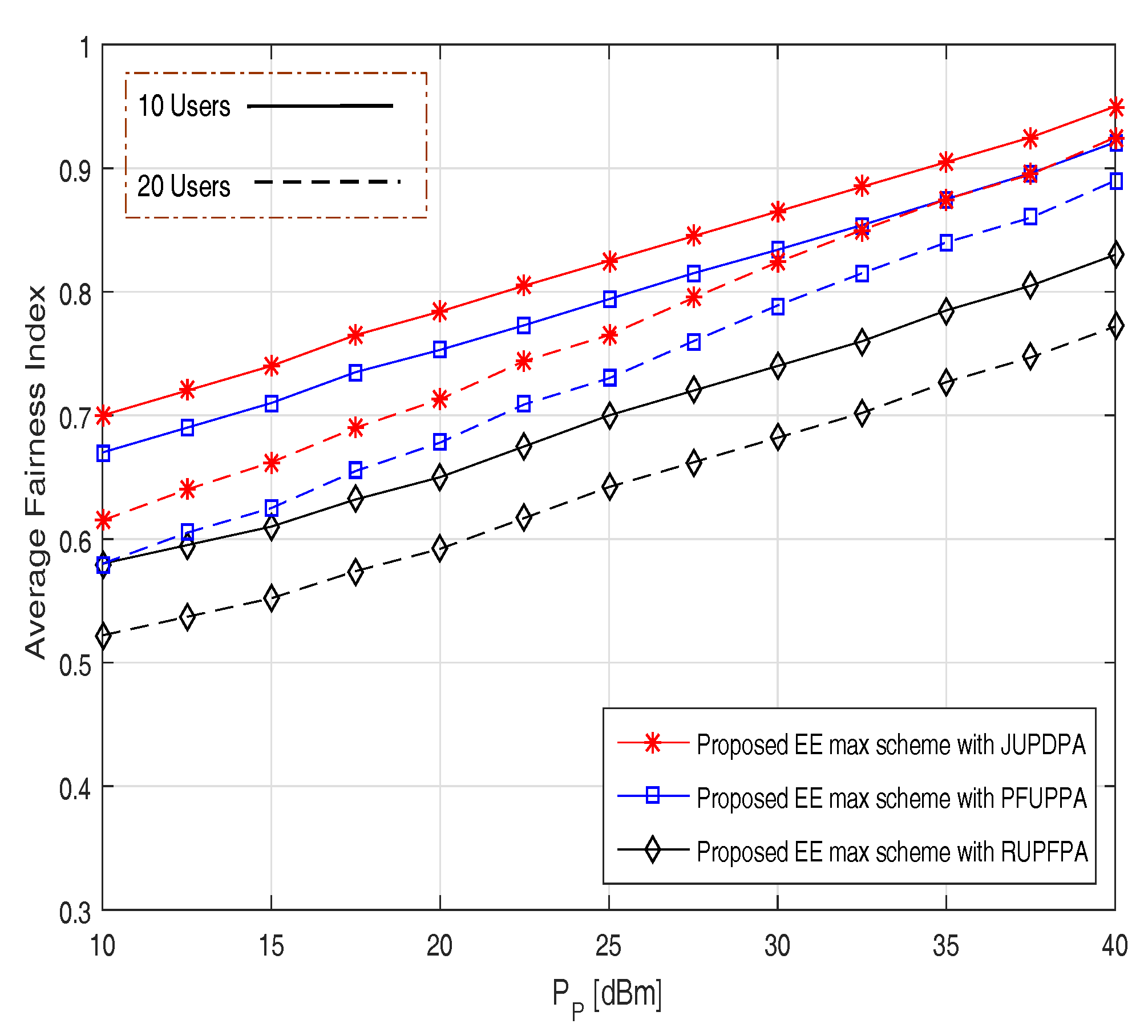
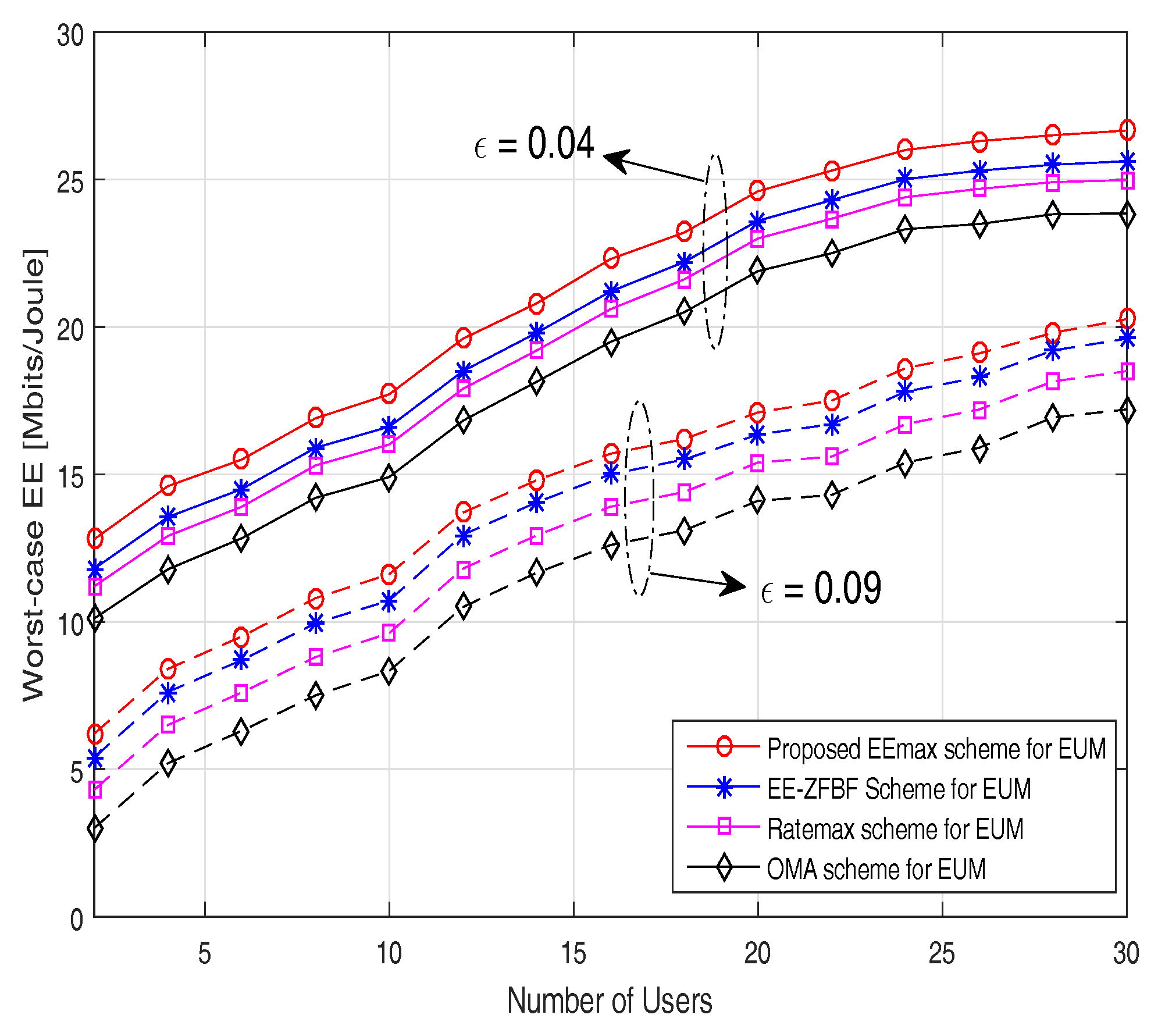
| CC Users | CC 1 | CC 2 | CC 3 | CC 4 | CC 5 |
|---|---|---|---|---|---|
| Power Allocation (PA) Coefficients | L (0.06) | 2L (0.12) | 3L (0.18) | 4L (0.24) | 5L (0.30) |
© 2017 by the authors. Licensee MDPI, Basel, Switzerland. This article is an open access article distributed under the terms and conditions of the Creative Commons Attribution (CC BY) license (http://creativecommons.org/licenses/by/4.0/).
Share and Cite
Chinnadurai, S.; Selvaprabhu, P.; Jeong, Y.; Jiang, X.; Lee, M.H. Worst-Case Energy Efficiency Maximization in a 5G Massive MIMO-NOMA System. Sensors 2017, 17, 2139. https://doi.org/10.3390/s17092139
Chinnadurai S, Selvaprabhu P, Jeong Y, Jiang X, Lee MH. Worst-Case Energy Efficiency Maximization in a 5G Massive MIMO-NOMA System. Sensors. 2017; 17(9):2139. https://doi.org/10.3390/s17092139
Chicago/Turabian StyleChinnadurai, Sunil, Poongundran Selvaprabhu, Yongchae Jeong, Xueqin Jiang, and Moon Ho Lee. 2017. "Worst-Case Energy Efficiency Maximization in a 5G Massive MIMO-NOMA System" Sensors 17, no. 9: 2139. https://doi.org/10.3390/s17092139





